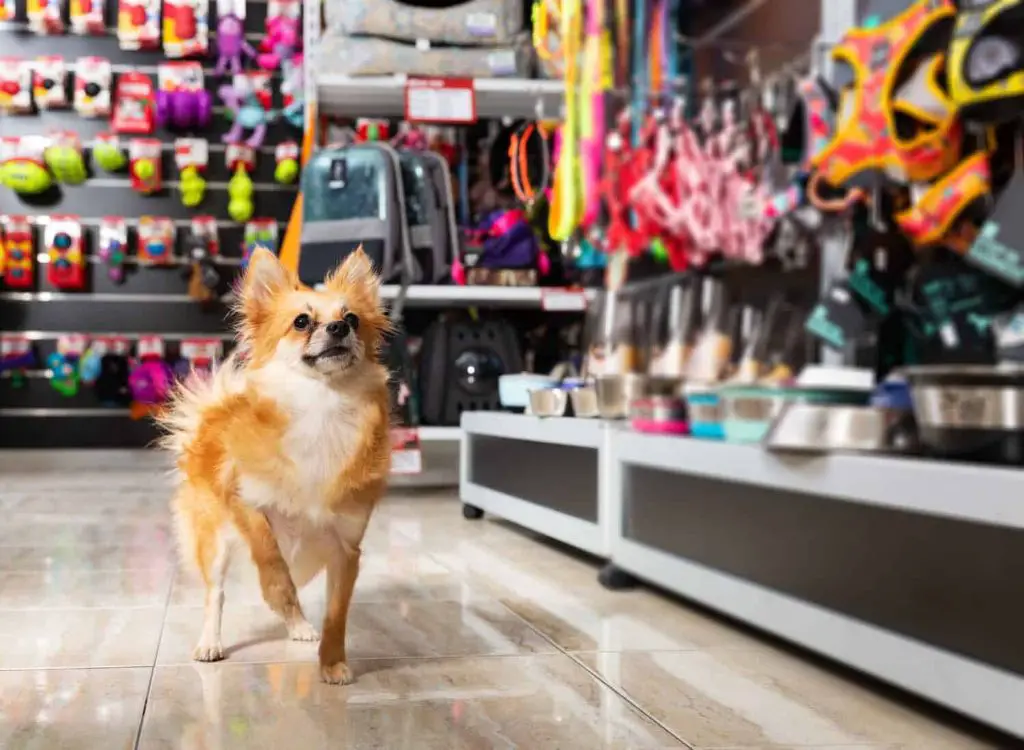Introduction
Many people consider their dog to be a member of the family. As such, they want their furry friend by their side as much as possible – even while shopping. In fact, according to a survey by Rover.com, 65% of dog owners have brought their pooch shopping with them in the past year. However, not all retailers are as welcoming to canine customers. This has sparked an intense debate around pets in retail stores. Should Fido be allowed to browse and try on clothes too? Or do unruly dogs threaten the shopping experience for other patrons and employees?
Background on Pets in Retail Stores
Many retail stores have specific policies regarding whether pets, especially dogs, are allowed inside their locations. These policies can vary widely between retailers and are sometimes left to the discretion of individual store managers. Some retail chains have an outright ban on pets for reasons like allergies, cleanliness, and safety. Meanwhile, others openly welcome pets as part of their brand image as pet-friendly businesses.
For example, hardware stores like Home Depot and Lowe’s typically allow leashed dogs since home improvement projects often involve pets. Most grocery stores do not allow dogs for health code reasons, with some exceptions for service animals. Clothing and department stores have more variable policies, with some banning dogs while others permit small pets if they are in carriers. Luxury retailers usually prohibit pets in order to maintain an exclusive atmosphere. In general, malls tend to not allow dogs unless they are service animals. However, more retailers have been opening up to allowing pets in recent years as a way to attract customers and stand out from competitors.
Why People Want to Bring Dogs Shopping
People bring their dogs shopping for a variety of reasons related to companionship and bonding. Leaving a dog home alone for hours can be stressful and lonely for some pets. Bringing them along provides comfort through togetherness and closeness.
Many pet owners consider their dogs to be members of the family. They enjoy spending time together running errands and partaking in daily activities. Going shopping allows people to get out of the house with their furry companions.
Dogs often act as social icebreakers and can make the shopping experience more enjoyable. Walking through stores with a cute canine attracts friendly attention from staff and other shoppers. For some, having their dog along makes them feel less anxious in public.

Additionally, the trip can serve as quality bonding time between pets and their owners. It provides mental stimulation and new sights and sounds to explore. Many dogs enjoy simply being by their human’s side no matter the location.
In short, companionship, avoiding loneliness, and strengthening the human-animal bond are top reasons people want to bring dogs shopping.
Benefits of Allowing Dogs
There are some clear advantages for retail stores when it comes to allowing customers to bring dogs inside. Two of the main benefits are drawing in more customers and generating positive public relations.
Having a pet-friendly environment can attract dog owners who want to be able to shop without having to leave their pets outside or at home. This widens the potential customer base for retailers. Additionally, many dog owners appreciate businesses that accommodate both them and their pets. This goodwill can lead to increased customer loyalty.
Allowing dogs also presents positive PR opportunities for retailers. Stores that welcome pets project an image of being family-friendly and community-oriented. Pet owners are likely to share on social media about their positive shopping experiences with their dogs. This free promotion can enhance a retailer’s brand reputation. The customer goodwill and word-of-mouth marketing around being dog-friendly builds community support for stores.

Challenges of Allowing Dogs
While many people love to shop with their dogs, retail stores face some challenges with allowing dogs inside. The main concerns around permitting dogs in stores involve allergies, cleanliness, and safety.
Dog dander and hair can trigger serious allergic reactions in some customers. People with dog allergies may experience sneezing, congestion, rashes, and asthma symptoms when exposed to dogs. If a customer has a severe dog allergy, coming into contact with traces of dog dander in a store could cause a serious allergic reaction.
Allowing dogs also presents cleanliness issues. Dog accidents on floors or merchandise could spread germs and stains. Even well-behaved dogs tend to shed hair and traces of dirt or mud from their paws as they walk around a store. This can quickly make a store look and feel less clean. Maintaining cleanliness standards requires additional work from staff when dogs are permitted.
Finally, permitting dogs raises some safety concerns. Even friendly, trained dogs may become frightened or startled in a busy store and nip or jump on people. Rowdy dogs could knock items off shelves or get tangled in clothing racks. Dogs may get loose from leashes and cause chaos. Dog fights could also erupt between unfriendly pets. These safety issues put employees and customers at risk of injury or harm.
H&M’s Official Policy
As of 2022, H&M does not have an official nationwide policy in the United States regarding bringing dogs into their stores. The decision is left up to the discretion of each store’s management. Some locations may allow small dogs to accompany shoppers, while others prohibit non-service animals. It is best to call your local H&M ahead of time to inquire about their specific rules before attempting to shop with your dog.
In general, H&M aims to provide all customers with a positive shopping experience. Store managers consider factors like cleanliness, allergies, and safety when deciding whether to allow pet dogs on a case-by-case basis. Representatives have indicated that small dogs who are well-behaved and restrained on a leash are more likely to be welcomed. However, barking, jumping, or destructive dogs will be asked to leave regardless of size.
Service dogs that assist customers with disabilities are always permitted in H&M locations under the Americans with Disabilities Act. Emotional support animals may also qualify if proper documentation is provided. But for the average pet dog, store managers have discretion over access. Calling ahead is advisable to prevent being turned away at the door.
Tips for Shopping with Dogs
If you want to bring your dog shopping with you, here are some tips to make the experience smooth and enjoyable for both you and your pup:
Train your dog to behave properly in public first. Make sure they will remain calm and listen to commands around lots of people, shopping carts, noises, and distractions. Work on “sit,” “stay,” and “focus” commands at home.
Bring treats and a collapsible water bowl so you can reward good behavior and keep your dog hydrated.
Use a short leash to maintain control at all times. Retractable leashes give too much freedom in a store environment.

Watch your dog closely and be considerate of others. Make sure your dog does not jump on people, knock items off shelves, or potty indoors.
If your dog seems stressed, distracted, or overstimulated, promptly exit the store. Don’t force them to stay if they are not comfortable.
Be prepared to leave if asked. Understand that not all stores welcome pets, even if leashed and well-behaved. Respect official policies and staff requests.
Shop at off-peak hours when stores are less crowded. This will be less stressful for your dog.
Consider using a dog carrier or stroller to keep pup close while leaving hands free for shopping. Some dogs feel safer up off the floor.
Bring clean-up bags in case of accidents and avoid having dogs interact with store merchandise or food products.
Ask permission before allowing your dog to approach other shoppers. Not everyone may be comfortable around dogs.
With the proper preparation and etiquette, bringing your well-trained dog along on a shopping trip can be a fun experience!
Opinions from Retail Experts
To get a better understanding of the challenges stores face in implementing pet policies, I interviewed several retail owners and dog trainers for their perspectives.
Sarah Wilson, owner of a boutique clothing store in Seattle, said she decided not to allow dogs after multiple incidents. “We had a few nice dogs come in, but also some with behavioral issues that barked at customers or urinated on the floor. The risk and liability isn’t worth it for us.”
Mark Davis, a dog trainer in Los Angeles, said some pet owners aren’t aware their dogs may misbehave. “Owners should train their dogs thoroughly before taking them into public spaces. However, many retail stores aren’t equipped to handle pets either.”
Amanda Clark, who manages a department store in Chicago, took a moderate stance. “We allow small dogs as long as they are leashed and don’t disturb other shoppers. But all pets are at the discretion of staff. This balanced policy works well for us.”
The experts provided valuable insights into the considerations retailers face. While some accommodate pets, poorly trained dogs can present risks. Retailers must weigh benefits against liabilities when establishing pet policies.
Case Studies of Retail Chains
Many major retail chains have adopted dog-friendly policies, while others maintain strict no-pet rules. Here are some examples of large retailers and their approaches to allowing dogs in stores:
Home Depot – Openly welcomes leashed dogs in their stores. They keep treats at the entrance to make dogs feel at home.
Lowe’s – Also allows leashed, well-behaved dogs in their stores. Employees may offer pets a complimentary bandana.
IKEA – Has a dog-friendly culture where leashed dogs are welcome. They even have a special ‘Dog Parking’ area.
Bass Pro Shops – Encourages shoppers to bring dogs along, with dog toys and bowls available. However, pets may be asked to leave for disruptive behavior.

Apple – Maintains a strict no pet policy for their retail stores, despite calls from some customers to allow dogs.
Target – Does not permit pets, except for service animals. They aim to provide a distraction-free shopping environment.
Costco – Only service dogs are allowed into their warehouse stores. Regular pets are prohibited by their membership agreement.
Conclusion
In summary, while many retail chains prohibit bringing dogs inside stores due to concerns around cleanliness, safety, and potential liability, some retailers like H&M maintain more flexible policies that permit pets on leashes. The decision comes down to each company’s values, customer base, and ability to set guidelines ensuring smooth operations alongside pets. While vigorous training helps mitigate risks, nothing eliminates them fully.
Ultimately, pet owners must educate themselves on policies and remain responsible. Where permitted, keep dogs controlled, clean, and calm to avoid incidents. Be ready to take them outside if needed. With thoughtful precautions, pets and shopping can coexist smoothly. Above all, show courtesy towards staff and other shoppers. Though rules vary by location, good judgment remains universal.